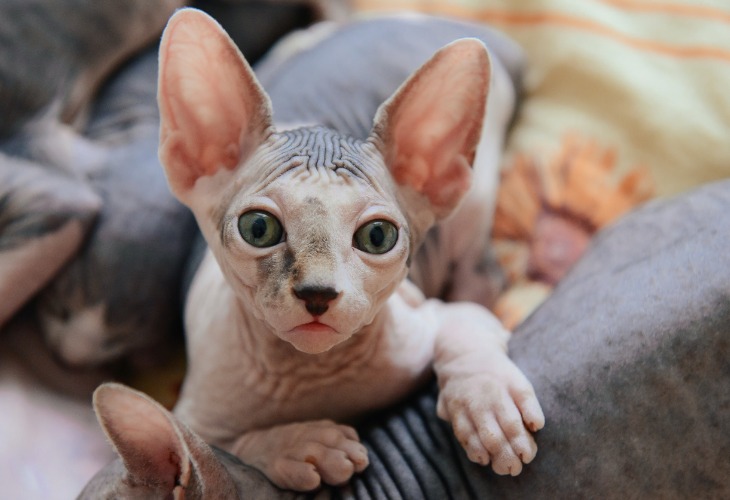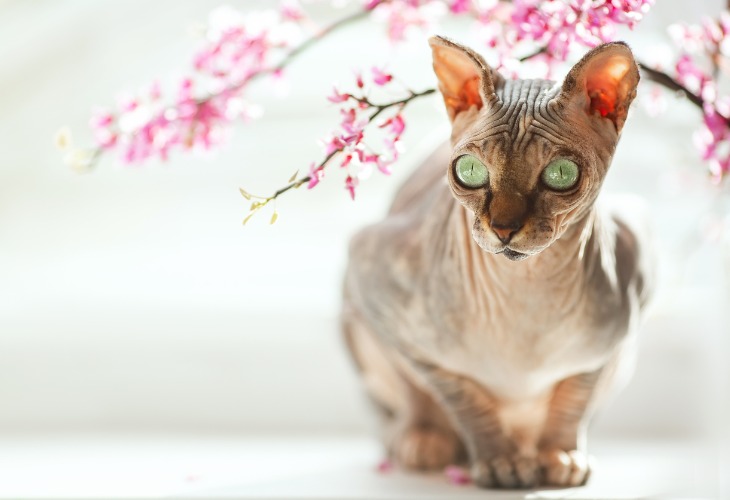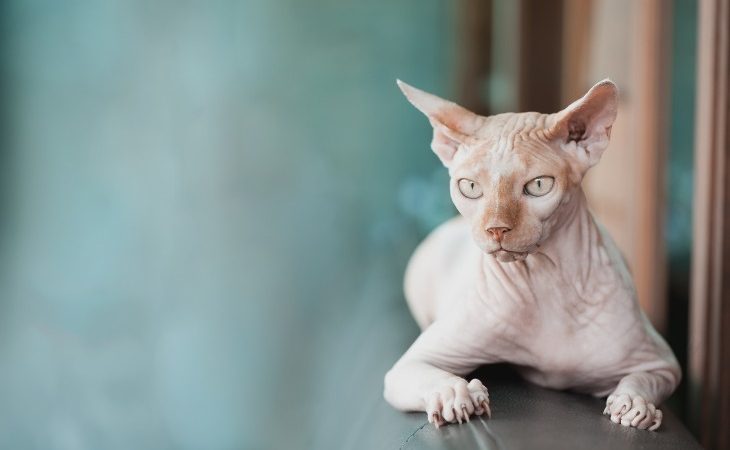Breed standard: CFA, FIFe, TICA, AACE, ACFA/CAA, CCA-AFC | Size: Medium | Life expectancy: 8+ years | Temperament: Calm, outgoing and affectionate | Coat: Hairless | Origin: Canada.
The Sphynx is one of the very rare cats in the world without fur. Its personality is often compared to that of a dog because it is loyal, outgoing, and affectionate.
Origins of the Sphynx
Prune and Bambi: the first modern Sphynxes
The first hairless cat, named Prune, was first found in Ontario near Toronto in 1966, in the litter of an alley cat. At the same time in Canada, another cat lover noticed a black and white hairless kitten in a litter. This kitten was named Bambi. These cats made it possible to discover and study the mutation responsible for the absence of hair in cats. Various more or less successful breeding attempts were made during the years that followed.
A healthy breed obtained after many crosses
The gene responsible for the hairless body of the Sphynx is recessive. This is one of the reasons why the pure breed was obtained after more than 30 years of crossbreeding. Devon Rex cats with little hair and hairless cats were crossbred. The crossbreeding was mostly done in France and some other European countries.
The Sphynx’s personality
Whether you think the Sphynx is cute or not, we can all agree that it is a unique and extraordinary cat breed.
What are the Sphynx’s qualities?
The Sphynx is an excellent pet. Calm and very affectionate, this breed likes to be cuddled. It is loving and appreciates caresses. The presence of their owner is reassuring to them and makes them feel safe. They can even sleep at the foot of their owner’s bed like a dog. This characteristic has earned them the nickname “cat-dog”. They like to bring back their toys and come to their owner when they are called. They are also known to be good hosts because they welcome visitors. The Sphynx likes to be the center of attention. This cat prefers to live indoors and tolerates the presence of children and other pets. Moving and long trips do not disturb it. It is not aggressive and can be curious.
Are there any downsides to having a Sphynx?
This cat breed can become very clingy and not want to be separated from its master, even just for a second. They constantly need someone available to give them affection. Contrary to what the absence of hair may lead you to believe, the Sphynx is not hypoallergenic. The antigens responsible for allergies are generally present in the saliva and the sebum released by the skin.

Physical characteristics of the Sphynx
This hairless feline has an inquisitive look.
General
The Sphynx has skin with many folds. It has wrinkles on its forehead, muzzle, chin, neck, and paws. The lack of hair is compensated by thicker skin than other cats. Under this skin is a large layer of fat to protect it from the cold. It can even go for walks outside during the winter. Despite the thickness of its skin, its veins are visible.
The skin of this hairless cat, like that of humans, breathes, tans, and gets dirty. Additionally, Sphynxes sweat and can get sunburned.
The Sphynx does not have whisker but this does not affect its physical abilities.
Head
The Sphynx’s head is more long than wide with angular contours. Its nose is long and of the same color as its skin. Its large and wide ears are similar to those of a bat. It has lemon-shaped eyes.

Body
The Sphynx has a medium and muscular body with a fine bone structure. Its chest is broad and its legs are long and slender. The paws are oval with long toes. Its whip-like tail is reminiscent of a rat’s. It also has a rounded belly.
Coat, grooming, and health
Coat
The Sphynx has no hair. However, its skin has many folds. While the Sphynx doesn’t have fur, it has a fine, soft, and warm type of fluff on its fur which gives it a feeling of peach skin to the touch. With that being said, the tip of its tail, its muzzle, and even the back of its ears may have hair. Many kittens are born with fur along their spine, but this disappears with age.
The color of the skin of a Sphynx depends on the color that its coat would have had if it had one. All colors are accepted for its coat. However, the absence of hair leads to a variation of the color, so a Sphynx with a white coat will appear rather pink. When the dress is black, the skin will be gray side.
Grooming
Sphynxes require special care when it comes to their skin. Because they are hairless, the sebum from their skin is not absorbed by any hair. This means that the Sphynx’s skin is naturally quite oily. Sphynxes, therefore, need to be washed weekly with wet gloves. Its skin must often be hydrated by creams or moisturizing lotions without odors. This is so that the folds present on its body remain well-maintained.
Their ears should be checked periodically, as hairless cats produce a lot of earwax. It is also important to keep them in a cozy and cool space, especially in summer to avoid sunburn. Sphynxes are very agile cats that love to climb everywhere. A cat tree will make allow them to climb and play inside the house. They should also be provided with a scratching post or have their claws trimmed regularly. This is especially the case if your cat is an indoor cat.
The Sphynx has a big appetite. To keep its body warm, it needs to eat more than the average cat. It is recommended to provide Sphynxes with premium kibble or to opt for special kibbles available in stores.
Did you know?
Here are some interesting facts about the Sphynx:
- This feline has a naturally higher body temperature (+4°C or +39°F) than other cats;
- The Sphynx is able to hold small objects with its toes;
- It is believed that the Aztecs venerated this cat breed in the past;
- This cat breed was called the “Canadian hairless” before being renamed Sphynx;
- The role of Mr. Bigglesworth was played by a Sphynx in the Austin Powers movies.
The Sphynx at a glance
Size: 30 cm (11.8 in).
Weight: from 3 kg to 5 kg (6.5 lbs to 11 lbs).
Health: The Sphynx is a generally healthy cat. It is, however, at risk for Feline Hypertrophic Cardiomyopathy (FHC), an inherited genetic disease that can skip a generation. It is not always obvious if a kitten will suffer from it. With this disease, the heart muscle becomes enlarged and can lead to heart failure.
Moreover, Sphynxes can also get sunburnt. For this reason, adapted sun creams must be applied on their skin to prevent sunburns.
Life expectancy: around 8 to 14 years.
Are Sphynxes good with children? As Sphynxes are very affectionate, lively, intelligent and playful, they like children and enjoy their attention.

